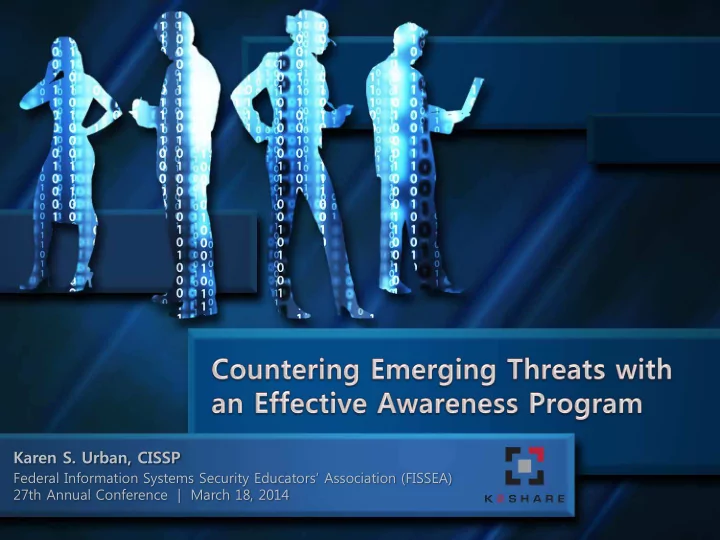

Karen S. Urban, CISSP Federal Information Systems Security Educators’ Association (FISSEA) 27th Annual Conference | March 18, 2014
Evolving Technology • Personnel expect greater mobility, connectivity, and networking capabilities • As a result, networks today are a mixture of organizational issued and personally owned smart phones, tablets, laptops and desktop systems
The Threat Landscape Today cyber attacks on private, public and government information systems are organized, disciplined, aggressive, sophisticated, and are becoming all too common
Personnel = Vulnerability Whether intentional or not, organizational personnel continue to be a leading cause of data breaches and network intrusions Of breaches were caused by 36% inadvertent misuse of data by employees* *Forrester’s “Understand the State of Data Security and Privacy Report”
P@s5w0rd$ 76% of network intrusions exploited weak or stolen credentials* *Verizon 2013 Data Breach Investigations Report Image above courtesy of SplashData
Willingness to “Click”
Good Intentions, Bad Results Unauthorized File Transfers
Social Media Oversharing
How to Defend Against Ourselves Implement, lead and sustain an active and aware cybersecurity culture!
Cyber Security Awareness Program Identify and target vulnerabilities introduced by • human behavior Include real-life scenarios which people may • actually encounter at work and at home Vary your delivery to capture and retain • attention considering the range of learning styles that exist today Utilize metrics to measure effectiveness over • time
Identify & Target Vulnerabilities Introduced by Human Behavior • Analyze information contained in security incident reports, audit reports and Plans of Action & Milestones (POA&M) • Examine organizational Policies and Procedures • Consult with organizational Security and Privacy Subject Matter Experts (SMEs) • Develop or Update a Security Awareness Baseline
• • Incident Reports Partner with members of your Security Operations Center and Incident Response Teams Analyze incident reports to identify incidents where the root cause was human behavior
• • Audit Reports and POA&Ms A closer look often reveals the root cause is human behavior Awareness training should be considered – even when a technical solution is recommended
• • • Policies and Procedures Identify potential gaps between requirements and actual implementation Review your Rules of Behavior (RoB) Consistent message between the awareness training program and other training
Consult with Security & Privacy SMEs Gain insight to: • Organizational strategies to mitigate risk • New or updated policies and procedures
• • • Develop or Update a Security Awareness Baseline Survey your personnel: Identify areas where awareness is lacking or perceived challenges exist Find out what they think will help them “behave in” instead of “behave out” Perform phishing exercises Informal outreach sessions
Learning Styles & Culture Telling is not learning • E-reading (PowerPoint and e-learning as fancy • PowerPoint) is not very effective except as an easy way to “check a box” Training only happens when the learner is • “training” themselves, i.e., they must focus on the training to progress; they must engage with problem solving; and they must have repeated practice using gained knowledge and skills
• • • Use Real-life Scenarios Training must be relevant to the learner Use real-life scenarios The more they can relate to and experience the scenario the more effectively they will remember what is being taught
• • Metrics & Continuous Monitoring Don’t try to focus on Use metrics like these to track progress and measure impact: everything; focus a few problem areas at # of personnel that successfully a time! pass phishing exercises Deliver training more # of personnel that didn’t pass phishing exercises often (not only once a # of personnel that report receipt year) so you can of a phishing exercise email address more topics # of actual phishing incidents throughout the year # of malware infected systems and based on real metrics
Putting These Concepts to Work The Department of Education’s FY 2014 Cyber Security & Privacy Awareness Course
Real-life Scenarios in Action
Repeat to Reinforce
Questions For additional information, please contact: Karen S. Urban PMP, CISSP, CISA, CRISC, GPEN Program Manager M 979.220.6810 | O 979.260.0030 Larry D. Teverbaugh, Ph.D., PE President & CEO M 979.777.1127 | O 979.260.0030 http://www.k2share.com | Veteran Owned Small Business
Recommend
More recommend